
surfresearch.com.au
surfing :
illawarra, australia
| home | catalogue | history | references | appendix |
 |
surfresearch.com.au
surfing :
illawarra, australia
|
|
W.
H. Broadhurst: Surfing [Surf
bathing], Thirroul, NSW, circa 1910.
- Wollongong City Library: Images SURFING [picture] Image Number: P10/P10157. Permission pending. |
| Following the war,
surfboard riding steadily gained further popularity and
spread along the coast, on occasion generating some
resistance. One of the early enthusiasts was photographed in front of the Stanwell Park-Helensburg SLSC, circa 1920. Right: Surfboard rider, Stanwell Park-Helensburg Life Saving Club, circa 1920. - Wollongong City Library: Images STANWELL PARK LIFE SAVING CLUB [picture] [Surfboard rider, Stanwell Park Life Saving Club, circa 1920.] Negative Number: FM2/81/2/22A Permission pending. |
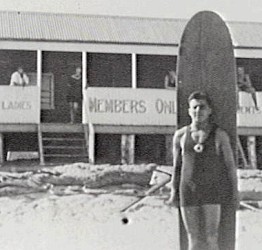 |
| Donald Arlie
"Mick' Warden (1904-1956) of Milton on the NSW south
coast, attended Hawkesbury Agricultural College along
with fellow swimmer Andrew "Boy Charlton. Following college, he moved to Wollongong and joined the Austinmer SLSC in 1922 and was a member of the recue and resuscitation team that won the Illawarra Branch Championship in 1924. In 1923, Olympic swimmer and Manly surfboard rider, Andrew "Boy" Charton visited Austinmer, where he stayed at Iden, the home of a Mrs. Warden, probably a relative of Mick Warden. While there, Charlton attended the Stanwell Park SLSC carnival, photographed (fifth from the left) with members of the Austinmer team. Returning in 1924, Charlton performed briefly in the local rock pool. |
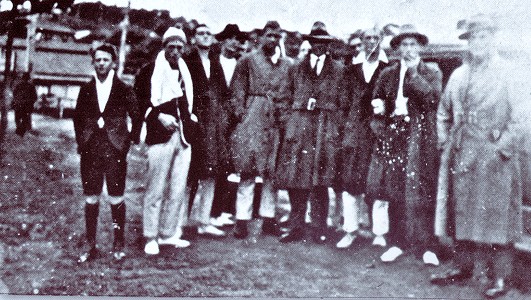 Andrew "Boy" Charton and members
of the
Austinmer SLSC, Stanwell Park, 1923. |
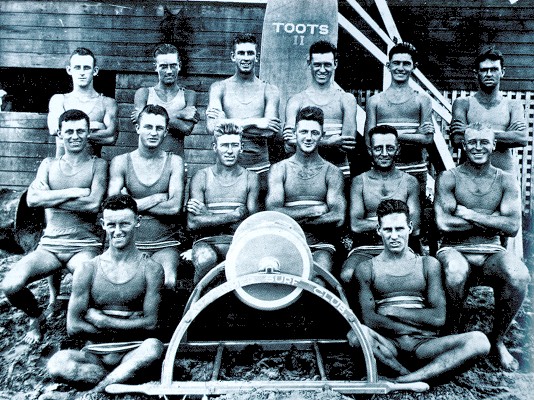 |
Austimer's champion R&R and surf teams with Toots II, circa 1925. Wilton and Salm : Austinmer SLSC (2009) page 13. Right: Frank Robson and Toots II, 1929. Detail from South Coast R&R Champions 1928-29. Wilton and Salm : Austinmer SLSC (2009) page 17. |
 |
|
"Hilo-born, A.
E.'Toots' Minveille was
the classic beachboy/waterman and the
father of Hawaiian outrigger canoe
racing. He was a fine swimmer, joined the Outrigger Canoe Club at age 14, and there was coached by Dad Center. While surveying on Moloka'i, Minveille conceived the idea of an outrigger race across the 26-mile Kaiwi Channel from Moloka'i to Oahu. Toots formed the International Hawai'ian Canoe Racing Association, which established the gruelling race in 1953, the premier event for outriggers. He is recognised for spreading the seeds of aloha and canoe paddling worldwide and is honored with a fine statue at Honolulu International Airport." (adjusted) Right: Toots Minveille, Outrigger Canoe Club entrance, Waikiki, 1927. Photograph: Arthur Yarborough - Dela Vega, et al.: Surfing in Hawaii, 1778-1930 (2011), page 125 . Also note the board marked Toots III, second from the right in: Jan. 1 1927 - Alawai, Honolulu - Hawaiian Championships. Blackburn: Surf's Up (2001) page 43: - noted by Ivan Johnson, phone call July 2011, many thanks to Ivan. |

|
 |
Toots
II was photographed with Fred Mumford outside the
original Mollymook surf club in 1938, and <MW>
, with a square nose and repairs, is currently held in
the Mollymook SLSC. Left: Fred Mumford and Toots II, Mollymook Surf Club, 1938. - Johnson: Mollymook SLSC (2010) pages 23 and 24. A surfboard, possibly <MW>, with a squared, or severely damaged, nose was photographed on Mollymook Beach in 1937, detail below. 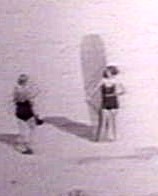 - State Library of NSW: Mollymook Beach, Milton
http://trove.nla.gov.au/version/18279504 |
| At Easter 1925, an instructional surf life saving team from
Sydney was head quartered at Kiama, with the purpose of
giving demonstrations there and at Crookhaven Heads,
Shellharbour, and Gerringong. The demonstrations featured "an exhibition of surf shooting on surf boards about 8 feet long, at which Messrs. Adrian Curlewis, Geofrey Bland and D. Lorking are experts." - The Kiama Independent, and Shoalhaven Advertiser, Saturday 4 April 1925, page 2. Adrian Curlewis joined the Palm Beach Life Saving Club in 1921, was taught to ride a surfboard there by John Ralston, and purchased his first surfboard from Manly's Claude West in 1923, "owner in hospital owing to using same." This was probably the board Curlewis rode, with considerable skill, in the Illawarra demonstrations. - The Australian Women's Weekly, Saturday 3 February 1951, page 17. |
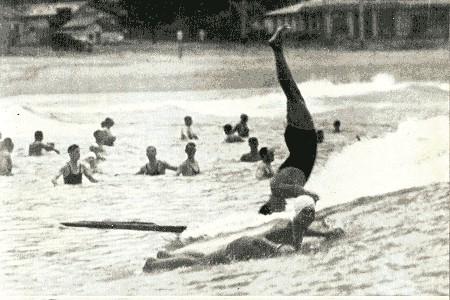 Adrian Curlewis, Palm
Beach, circa 1929.
- Maxwell: Surf (1949) , facing page 208. Note that the other boardrider in the phototgraph is female. |
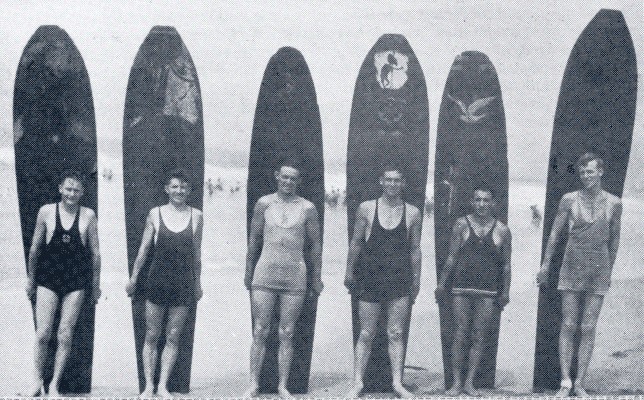
| In the
later 1930s, surf-skis began to vie with surfboards in
popularity. The models of this period featured a prominant splash guard and a leash attaching the paddle to the nose, and were occasionally ridden while standing. Several surf-ski riders were photographed in the Illawarra, circa 1936. Right: Surf-ski riders, Illawarra, 1936. - Wollongong City Library: Images SURFING [picture] 1924; 1920-1930. Image Number: P13/P13836. Permission pending. |
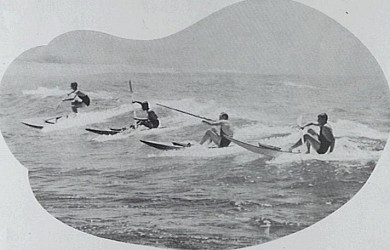 |
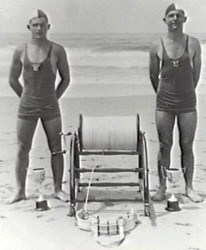 |
Left: Walter [and Jack] Dare, Corrimal Beach, 1937. Right: Walter Dare, Surf-ski Headstand, Corrimal Beach, 1937. - Wollongong
City Library: Images
|
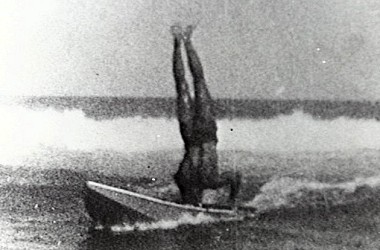 |
| CORRIMAL
SURF LIFE SAVING CLUB [picture] 1937; 1930-1940. Image Number: P05/P05729. |
DARE,
Walter [picture]
1937; 1930-1940. Image Number: P06/P06433. Permissions pending. |
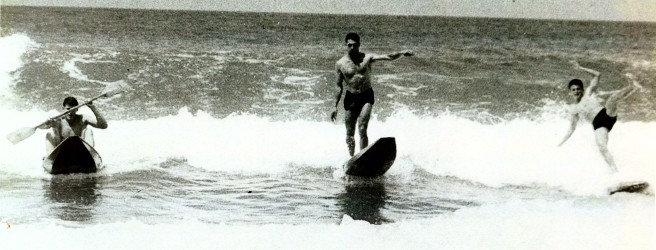 Dennis
Taylor [surf-ski], Arthur Morris and
Colin
DeMestre on hollow boards,
Wollongong Beach, June 1958. [The date confirmed, with thanks, Neville de Mestre, May 2014.] 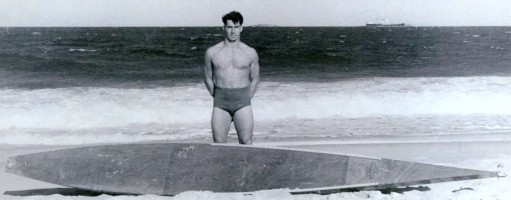 Arthur Morris with 16ft Toothpick at South Wollongong, circa 1950. Photographs courtesy of Arthur and Craig Morris, December 2013. |
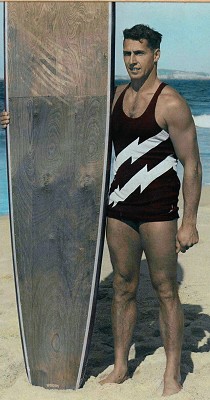 Mr. Morris
[and Gordon Woods Hollow board] Winner Illawarra Branch Surf Board Championship, 1950-51. Below: Gordon Woods decal, detail.  |
| Another
of the first Australian's to ride the Malibu board was
possibly longtime Wollongong Surf Life
Saving Club member and noted board rider, Ted (Edward)
Burns. In early 1945, it was reported that Burns had resigned as the club's R and R and the chief instructor. However, several months later, the Sydney Morning Herald noted that Ted Burns' innovation of towing a small sea anchor "is revolutionising training methods for belt swimming competitions." Burns was identified here as the "chief instructor of the Wollongong Surf Life-Saving Club." - Illawarra Mercury, Friday 26 January 1945 page 5. - Sydney Morning Herald, Wednesday 4 April 1945, page 9. |
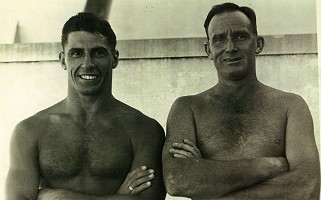 Arthur Morris and Ted
(Edward) Burns,
circa 1950. Photograph courtesy Arthur and Craig Morris, 6 December 2013. |
|
In 1954, the Werri Beach Surf life Saving
Club celebrated the opening of their new club house
with a surf carnival
display, where the surfboard race was won by
G. Miller of Port Kembla, with Ted Burns second.
- Kiama Independent (NSW : 1947 - 1954), 13 March 1954, p. 4, viewed 29 November, 2013, http://nla.gov.au/nla.news-article105769058 In 2000, the History of Wollongong City SLSC included a photograph of Ted Burns with the caption: "Ted Burns competing at Makaha in 1950- said to be the first Australian to compete in Hawaii." - Looking Forward- Looking Back: History of Wollongong City SLSC, 1915-2000 (2000), page 27. The Makaha International Surfing Championship(s) was first successfully held in 1954, won by master-surfrider George Downing, and it came to be widely considered as the unofficial world championships. |
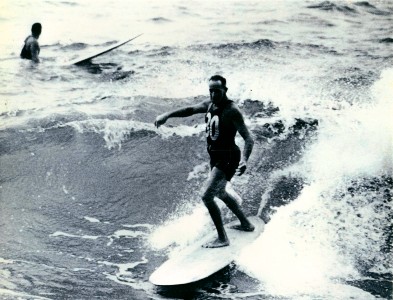 Ted Burns, Balsa
Pig, Makaha International
Surfing Championships, circa
1958.
Photograph courtesy of Arthur and Craig Morris, 6 December 2013. |
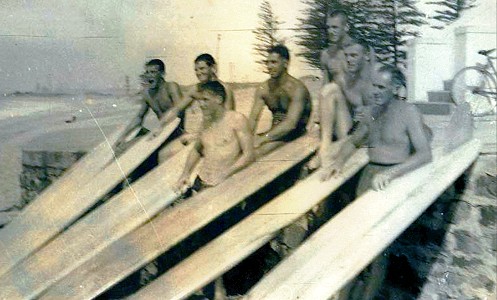 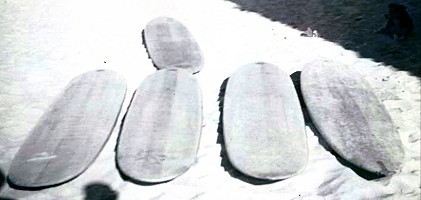
|
Right: Neville
DeMestre,
T. Carney, B. Bowan, A. Morris,
G. Barnes, N.Martin, and Ted Burns, South Wollongong Beach, circa 1958. 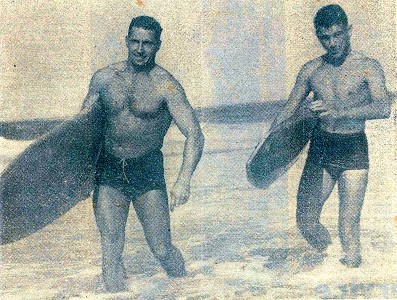 Above: Permanent lifesaver Arthur Morris and Neville DeMestre, Wollongong Beach, May 1959? Right: Five Balsawood Malibu Surfboards, South Wollongong Beach, circa 1958. Photographs courtesy of Arthur and Craig Morris, 6 December 2013. |
| Around this time, Dave
Anderton, of the North Wollongong SLSC, also obtained
a balsa board from Sydney "surfboat builder, Bill
Clymer. A Pigboard, around 9 to 10 foot long, (with) a round nose, wide curved tail, and a big wooden fin, (it featured) cedar inlaid rails." (edited) Owen Jones found the board "different and exciting to ride, so much easier than the toothpicks!" In 2012, Owen identified the board in the photograph right, with the distinct cedar rails, as one built by Bill Clymer and in Sptember 2015, the surfer as Hughie Brandon.. - Owen Jones: The North 'Gong Boys Story, circa 1958 to 1967. laybacks.com.au/wp/wp-content/uploads/.../The-North-Gong-Boys.pdf Right: Surfriders and Bill Clymer Balsa Pig Surfboard, North Wollongong Beach, 1958. -Wollongong City Library: Images WOLLONGONG - Beaches - North Wollongong Beach [picture] 1956; 1950-1960. Image Number: P04/P04217. Permission pending. Note that the catalogue date of 1956 is, almost certainly, too early. Given the prominance of the board in the photograph, and that one of the surfers is wearing a bikini, this was probably taken by a newspaper photographer, possibly for a related article. |
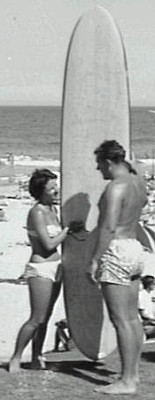 |
| Owen
Jones noted the importance and influence of the
local gallery: Some of us would watch the surfing and comment on who got the better waves and who surfed the best on the day, amongst loud cheers, hoots and hollers, and laughter at the antics of the surfers .. a new, exciting, and beautiful event. This ad hoc group of enthusiasts was the core of the Wollongong Boardriders Club, formed in Ted Meare's Parents' house garage around 1963-1965. - Owen Jones: The North 'Gong Boys Story, circa 1958 to 1967.. (undated) laybacks.com.au/wp/wp-content/uploads/.../The-North-Gong-Boys.pdf - Owen Jones: additional comments phone conversation, 30 November 2013, with many thanks. In 1968-1969, Owen Jones travelled to South Africa, meeting up with Shellharbour's John Batchelador and Tony Wright (see below), and in the early 1970s, he relocated to the North Shore of Oahu. After surfing at Pipeline, Owen was photographed leaving the water by Jeff Devine, circa 1972. See: https://blog.samys.com/jeff-dvine/ Owen
Jones : Pipeline, dog and rainbow, 1972.
Photograph: Jeff Devine Nat Young : History (1983) pages 12-13. |
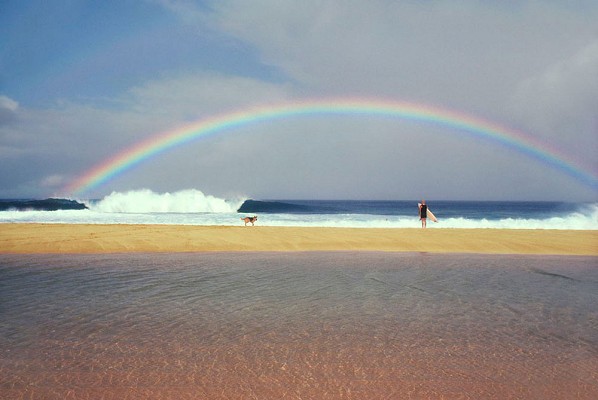 |
| Around
1958, boatbuilder Ron Cansdell and Cronulla
boardrider Brian Jackson started Jackson and Cansdell Surfboards at 59 The Bouvevade,
Caringbah. Shortly after this, they open an outlet in North Wollongong, and in 1963 factory at 426 Princes Highway Corrimal. At this time teamriders included Wollongong's John Skipp and Mick Carrabine, along with one of the premier riders of the period, Cronulla's Bobby Brown. Skipp and Carrabine would later have extended careers as surfboard manufacturers in Flinders Street, Wollongong. Right: Jackson and Cansdell Surfboards Advertisement, 1963. (cropped-the top of the
page has an inverted photograph of Bobby Brown)
- Surfabout, Volume 1 Number 5 page 32. |
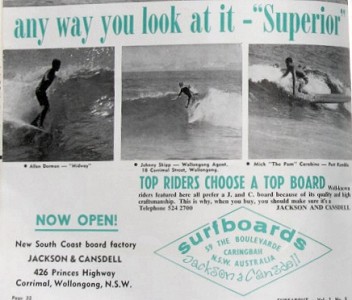 |
| Some
of the last
photographs of Bobby Brown, now riding for Gordon and
Smith Surboards, were taken by Cronulla's Jack Eden, at Sandon Point shortly
before his untimely death in August 1967. Right: Bobby Brown, Gordon and Smith Stringerless, Sandon Point, mid-1967. Photograph: Jack Eden. This photograph, and several others, are featured in: Margan and Finney: Pictorial History (1970), including some in colour. |
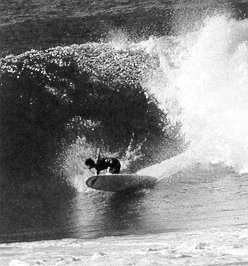 |
| In 1968 Jackson Surfboards
released the Frogman (Tracker) model shaped
by Laurie "Froggy" Byrne from Currarong. Skipp and Carrabine would later have extended careers as surfboard manufacturers in Flinders Street, Wollongong, and Laurie Byrne continued his shaping at (Phil and Dave's) Bryne Surfboards at Fairy Meadow. He shaped some of the first boards for Wollongong grommets, Phil and Dave Byrne, and is currently providing boards for Owen Wright and Dean Bowen. |
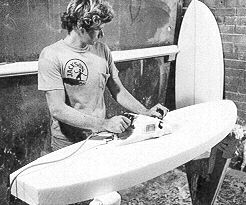 |
| One of the earliest
Wollongong fibreglass surfboard builders was Colin
"Biggsy" Ashford. He began his shaping career in "a converted chook pen in the backyard at Stanwell Park" in the early 1960s by stripping and reshaping balsa boards, discarded after the introduction of foam blanks. Materials were sourced from Cansdell and Jackson Surfboards, Caringbah, or King Surfboards, Kirrawee. In 1966, with schoolmate Bill Trestrail, he started the short-lived Bill Collins Surfboards in a disused ex-service station on the hill at Stanwell Park. This was followed by a brief stint in a shed at Kennedys Hill, Thirroul, before he relocated to a workshop at 30 Flinders Street Wollongong from 1967 to 1974. During 1976 -1977, Ashford continued making boards at home as Sybernaught and Seaglass Surfboards, retailed through David Matthew's Southern Man surf shop at Ulladulla. Colin Ashford moved to Lake Conjola in the early 1990s, and is currently building hollow wooden boards, shaped from home-grown paulownia. - Collins Green Island Hollow Wood Surfboards http://collinswoodensurfboards.weebly.com/old-surf-photos--boards.html |
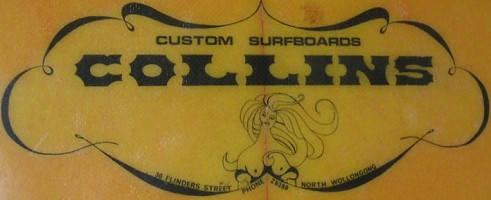 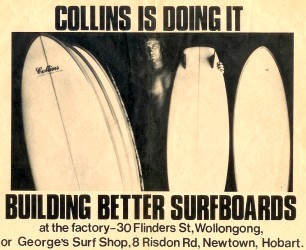 Collins Surfboards Advertisement, Tracks, circa 1971. |
| Skipp
Surfboards John Skipp was a agent and team rider for Jackson Surfboards, before starting Skipp Williams Surfboards at 24 Flinders Street North Wollongong NSW in 1970. - Advertisement, Tracks, December 1970, page 28. After a short time, the company became Skipp Surfboards, at the the same, and still current, address. Over the years the company featured the core of the Illawarra surfboard industry, including Paul Nichol, Phil Byrne, Dave Byrne, Terry Richardson, Terry Cooper, Chris Horne, Kevin Parkinson, Richard Palmer, Ed Sinnott and, the late, Frank Latta. Top: Port Kembla on the NSW South coast. In a cold weather crouch, Jonny Skipp, improvises. - Pollard: Australian Surfrider (1963), page 110. Bottom: Skipp decal, circa 1974. |
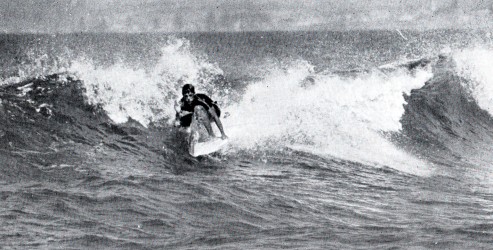 |
| Byrne Surfboards
The Byrne brothers, Phil and Dave opened their factory at Fairy Meadow in1975, and was immediately popular. The shapers included longtime shaper Laurie Byrne, who later designed the Twin-fin Clinker model, circa 1980, and Terry Cooper. Phil Byrne shaped boards for the 1983-1984 world champion, Tom Carroll and produced the Tom Carroll model. Dave Byrne competed as a junior and in the early years of the pro-surfing era, followed by younger brother Chris Critta" Byrne. In the late 1970s, the company produced Australian models for South Africa's Shaun Thomson's Instinct Surfboards and Hawaiian Pro-Design by Larry Bertlemann. Right: Chris "Critta' Bryne, Bryne Surfboards Flyer Rounded Pintail, citca 1979. |
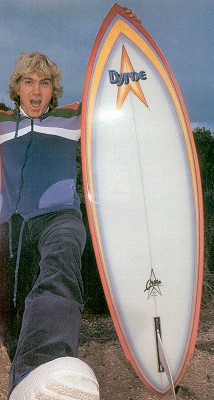 |
| Kiama Right: Malibu riders and one surf ski in Kiama Harbour, circa 1963. - Kiama Council Library: Images ??? Permission pending |
| Kevin Parkinson Kevin Parkinson, north Wollongong, was one of the Illwarra's most skilled and competitive boardriders. In 1967, he came third in Australian Titles at Bells Beach, behind Wayne Lynch and 'Butch' Cooney. He shaped for Skipp Surfboards, Carabine surboards 1977; Hotline Surfboards, c 1979. - http://en.wordpress.com/tag/kevin-parkinson-surfer/ Right: Kevin Parkinson, Bellambi Pier, c 1962. - Margan and Finney: Pictorial History (1970) page 281. |
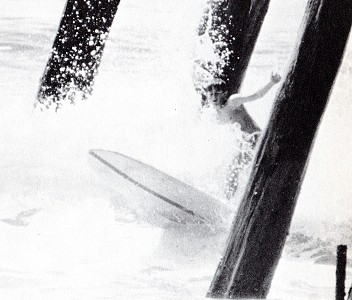 |
 Kevin Parkinson, Toes on the Nose, c 1964. - [Jack Eden] Margan and Finney: Pictorial History (1970) page 259. |
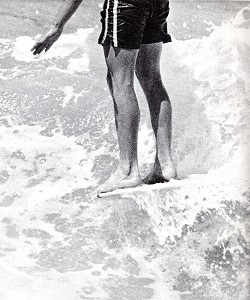 Phil [Kevin] Parkinson, Toes on the Nose, c 1966. - [Jack Eden] Margan and Finney: Pictorial History (1970) page 262. |
| Ken Middleton Right: Ken Middleton, Shellharbour Harbour, c 1965. - [Dave Milne] Margan and Finney: Pictorial History (1970) page 270. |
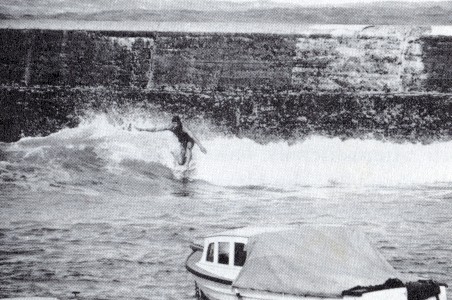 |
| Paul
Brooks Right: Paul Brooks Port Kembla Beach late 60s - http://www.edsinnott.com.au/History of Surfing/ |
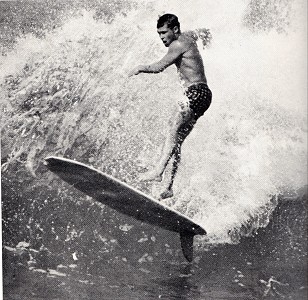 Donald
'Sticky' Spearpoint, Warrilla
Beach, circa
1964.
- Pollard: The Surfrider (1968), page 84. |
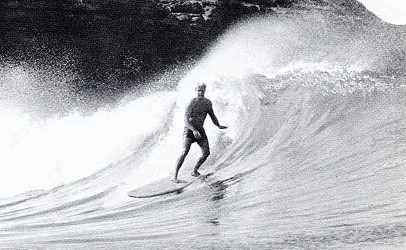 [Albert
Fox], Windang Island,
circa 1964.
- Margan and Finney: Pictorial History (1970) page 281. |

| home | catalogue | history | references | appendix |